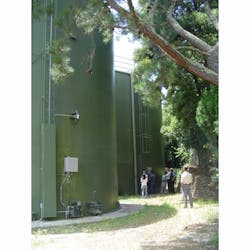Mixer Tames Nitrification in Water Tank
Redwood City, Calif., operates a 500,000-gal ground-level steel tank with a single inlet/outlet. Located in the Bay Area of Northern California, Redwood City purchases chloraminated water from a regional wholesale supplier. During the summer, the total chlorine residual of samples taken near the bottom of the tank typically remained at the target level of 2.0 mg/L, but residual levels in samples taken from the top few feet of the water inside the tank would drop significantly, sometimes to undetectable levels. This was of particular concern due to the increased risk of nitrification in upper layers of the tank and the associated mitigation costs and negative impacts on water quality from such an event.
Further investigation revealed that thermal stratification was inhibiting mixing in the upper layers of the tank, leading to excessive water age and residual loss. A plot showing the total chlorine residual dropping appears in Figure 1 and correlates well with establishment of the different layers within the tank (Figure 2).
The Solution
In-tank mixing is an effective solution for preventing the onset of nitrification. Mixing can prevent stratification and ensure that fresh incoming water with high disinfectant residual mixes with the older, low-residual stratified water.
The PAX Water Mixer is an example of in-tank mixing technology that eliminates thermal stratification and ensures an even distribution of chemical residual throughout the tank. Using proprietary PAX impeller technology, the mixer easily installs through a conventional hatch. Two PAX representatives and a two-man diving crew installed the PAX Water Mixer in the Redwood City tank on July 19, 2006. The complete installation took less than two hours.
As shown in Figure 3, the problem was solved. Total chlorine levels were restored throughout the tank and temperature stratification was eliminated. Additional chemicals were not required onsite, and readings taken from the tank sample tap became representative of overall tank water quality. In addition, a sudden spike in nitrite levels was halted and reversed, indicating that the mixer was installed just in time to help prevent a nitrification episode (Figure 4).
Figure 5 illustrates the ability of the PAX Water Mixer to break stratification within a few hours of startup and then maintain a uniform temperature throughout the tank. This type of rapid, complete mixing is made possible by the strong axial jet of colder water from the bottom of the tank that breaks through established thermoclines, and the coherent toroidal flow structure set up by the PAX mixing impeller, which facilitates mixing of large water volumes typical of storage tanks.
The Conclusion
Conclusions drawn from both chemical and temperature data were consistent—the PAX Water Mixer completely mixed the 500,000-gal ground-level steel tank. Thermal stratification was eliminated and target disinfectant residual levels were restored throughout the tank.
In addition, a potential nitrification event was prevented directly after the installation, and the thoroughly mixed condition in the tank prevented the onset of any other nitrification events during the remainder of the problematic warm-weather months.
“We installed a PAX mixer in a problematic half-million-gal reservoir two summers ago,” said Dan Heimel, former water quality specialist for the City of Redwood City, in 2008. “Since then, we have seen excellent mixing throughout the entire tank and there have been no indicators of nitrification. The PAX mixer solved our thermal stratification problem and continues to maintain great water quality.”
